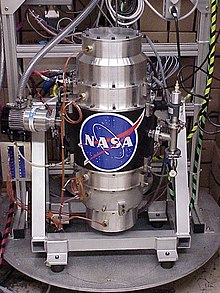
Flywheel energy storage (FES) works by accelerating a rotor (flywheel) to a very high speed and maintaining the energy in the system as rotational energy. When energy is extracted from the system, the flywheel's rotational speed is reduced as a consequence of the principle of conservation of energy; adding energy to the system correspondingly results in an increase in the speed of the flywheel.
Most FES systems use electricity to accelerate and decelerate the flywheel, but devices that directly use mechanical energy are being developed.[1]
Advanced FES systems have rotors made of high strength carbon-fiber composites, suspended by magnetic bearings, and spinning at speeds from 20,000 to over 50,000 rpm in a vacuum enclosure.[2] Such flywheels can come up to speed in a matter of minutes – reaching their energy capacity much more quickly than some other forms of storage.[2]
- ^ Torotrak Toroidal variable drive CVT Archived May 16, 2011, at the Wayback Machine, retrieved June 7, 2007.
- ^ a b Castelvecchi, Davide (May 19, 2007). "Spinning into control: High-tech reincarnations of an ancient way of storing energy". Science News. 17 (20): 312–313. doi:10.1002/scin.2007.5591712010. Archived from the original on June 6, 2014. Retrieved August 2, 2012.